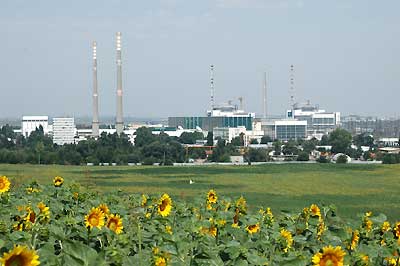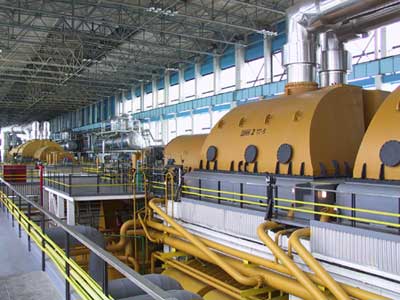
European
Nuclear Society
e-news
Issue 21 Summer 2008
http://www.euronuclear.org/e-news/e-news-21/kozloduy.htm

The Kyoto Protocol, which was signed in December 1997 in Kyoto, Japan, under the auspices of the United Nations, was the political beginning of the process for limiting and reducing the emitting of greenhouse gasses into the atmosphere. For the first time in the world the Clean Development Mechanism is being implemented with the objective of investing in environmental projects that reduce greenhouse gas emissions in developing countries. The financing of these projects is provided through the punitive sanctions imposed on industrialized countries and countries in transition, including Bulgaria, which are in breach of their Protocol commitments.

With regards to the process of Bulgaria’s accession to the European Union, the World Bank has estimated that the environmental protection costs to be paid by our country, by the year 2015, will amount to 6,1 - 8,6 billion €. Part of these costs result from the country's commitment to reducing its greenhouse gas emissions, the main source of which are conventional fossil-fired plants and vehicles that run off organic fuels.
One of the fundamental components of Bulgaria’s economic competitiveness is the development of cheap and clean electricity. Today, this is impossible without nuclear power’s environmentally friendly profile and virtual inexhaustibility. The shutting down of the first four units at Kozloduy NPP, with the environmental consequences that this decision provoked in different regions of our country, underlined the truth of this statement.
Our NPP, the only one in operation for the time being, employs a WWER (Water – Water Energetic Reactor) first and second generation reactor type that is analogous to a PWR type (pressurized water reactors) reactor that is widely used in Western countries. Its units have been operating for more than 100 reactor years and over that period they have proven their operational reliability and safety as a source of cheap electricity providing the main base load for the country’s electricity grid.
Nevertheless, at an early stage of reactor design the “small” units (WWER-440/ V230) demonstrated a number of innovative solutions, which provided a basis for the design of the next generation of reactor units.
The design of the reactor unit incorporated a number of design and engineering solutions that ensured its "interior self-protection" and provided a high level of plant safety and reliability. These were as follows:
a high level (to maximum design safety margins) of reactor core thermal reliability
high reliability of the reactor with regards to possible deviations from basic operational parameters (self-regulation)
stable natural circulation of primary coolant, allowing removal of up to 9% of the reactor thermal power in emergency modes
a high level of redundancy of heat removal system – 6 circulation loops
a large water reserve in the steam generators, allowing long-term residual energy removal without feed/after reactor shutdown
use of high-strength steel for the reactor pressure vessels
use of high plastic-stainless steel for the primary equipment and pipes, which allows the application of the “Leak- Before Break” principle
two turbine generators, which allow continuous operation at power rate different from the nominal rate
The advantages of the Kozloduy reactors are best described by Western European Nuclear Regulator’s Association (WENRA) in its report of 1999. “…When assessing the safety of a WWER-440/230 nuclear power plant it should be pointed out that these reactors similar to all WWER 440 reactors feature intrinsic safety parameters surpassing those of the modern western NPPs.
…The amount of coolant per megawatt is two times than the amount of coolant in any western NPP.
… These safety parameters provide efficient protection against potential deteriorating of the most transients into more severe accidents.”

The NPP is a capital-intensive installation – approximately 2000€/megawatt generating capacity. Experience in the developed nuclear countries has shown that the continuous operation of reactors, under guaranteed safety conditions, is cost-efficient - costing approximately one tenth of the initial investment. The WWER – 440 Model 230 reactors, which have been installed in Russia, have already been granted a license for the extension their operational life time for a further 15 years after modernization.
In 2002 the International Atomic Energy Agency (IAEA) visited Bulgaria in order to review the implementation of recommendations for the design of “small" units. Based on its review of the results the IAEA team declared that the operational and design safety of Units 3&4 at Kozloduy NPP were in compliance with the safety standards achieved by the plants of the same generation. They also reported that most of the measurements carried out exceeded the scope of recommendations made for the plant design, operation and seismic performance, and that the plant personnel was highly qualified and personally committed to the improvement of operational safety. This constituted a guarantee for the continuation of this trend. This disproved the claim made by the experts from G-group that such units “can not be modernized” at a reasonable cost.
Bulgaria, with its well established traditions and culture, human potential, natural resources and production capacities, is already a full member of the European Union. Kozloduy NPP is the pearl of our power sector, thus our country ranks deservedly with developed nuclear countries that ave advanced electricity generation technologies. The plant’s long-term operational safety gives good grounds for the construction of new nuclear installations.
This is why the Bulgaria Nuclear Society, since it was established, has defended the ''small units" at Kozloduy NPP and has voiced its conviction that it is the duty of every Bulgarian citizen to protect the country's national wealth. There are no sound arguments for the “Mercedes” of our national power sector to be being “kept in the garage” while “Trabants” continue to emit ash and poisonous gases onto the nation’s roads.
All experts in this field, most Bulgarian citizens and most European citizens have been convinced of this for a long time. The time has come to convince European Union politicians as well.
![]()
© European Nuclear Society, 2008